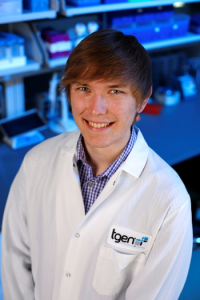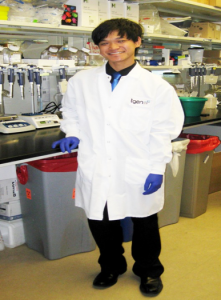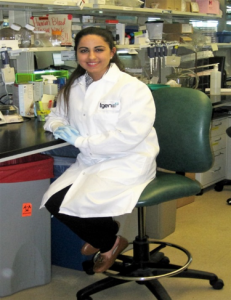The Ivy Neurological Science Internship Program aims to inspire high school and undergraduate students to pursue careers in bioscience, with a focus on glioma research, neuroscience, and neurogenomics. This fully-funded program offers students the unique opportunity to conduct hands-on biomedical research under the direct mentorship of a TGen investigator, providing a pathway for future leaders in science and medicine.
Program Summary
Modeled after the Helios Scholars Program, the Ivy Neurological Sciences Internship Program replicates three key features that we have found instrumental to that training program’s success:
- Research Internships: Promising high school and undergraduate students receive fully-funded opportunities to engage in groundbreaking research.
- Clinical Exposure: Participants gain insights into translational and clinical medicine through partnerships with local healthcare and research institutions.
- Research Presentation: At the program’s conclusion, students present their research findings to faculty, peers, family, and community members.
A Decade of Impact
Now in its eleventh year, the Ivy Neurological Science Internship Program continues to provide invaluable exposure to modern laboratory techniques and cutting-edge neurological research. Ivy Scholars leave the program with a solid foundation upon which to launch their careers, contributing to advancements in brain cancer and neurological disease research. Many alumni have gone on to excel at prestigious universities and research institutes, with several continuing to focus on improving outcomes for patients suffering from brain tumors and other neurological conditions.
Fostering the Next Generation of Scientists
Through this program, students not only deepen their understanding of the complexities surrounding brain tumor and neurological research but also develop a profound sense of purpose in bringing hope to patients and their families. Over the past eleven years, we have proudly celebrated the achievements of our Ivy alumni, who have emerged as influential voices within the scientific community. The Ivy Neurological Science Internship Program embodies the Ben and Catherine Ivy Foundation’s steadfast commitment to advancing education and research. We remain dedicated to cultivating the next generation of researchers and physicians committed to improving outcomes for those affected by brain tumors and neurological diseases.
Apply Today
If you’re a high school or undergraduate student passionate about science and eager to make a difference, consider applying for the Ivy Neurological Science Internship Program. Together, we can inspire the next wave of scientific leaders and drive meaningful progress in the fight against brain cancer and neurological diseases.
Ivy Neurological Science Internship Program
2023-2024
CALEB SHAFFER

GAP Year Research Associate
Research Summary
Glioblastoma treatment strategies
Glioblastoma (GBM) is the most prevalent type of malignant tumor within the central nervous system. The five-year survival rate of 6.8% highlights the challenges inherent to exceptionally heterogeneous tumors that grow behind the blood brain barrier. The protracted dearth in new agents approved for GBM begs innovative strategies by which to approach clinical trials. Attempts to use FDA approved treatments for other cancer types in case of GBM often leads to mixed results in preclinical testing and clinical trials. Arsenic trioxide (ATO) is the standard of care for myelodysplasia and relapsed or refractory acute promyelocytic leukemia. ATO has an idiopathic mechanism of action but has shown beneficial effects in other solid tumors. Combination strategies utilizing ATO in combination with MNK1 inhibitors have shown great sensitizing effects in GBM models. Through my research I have uncovered molecular signatures which appear predictive of response to this combination. Understanding what characteristics are inherent to responsive cases can allow us to stratify patients based upon expected response personalizing treatment assignment in clinical settings. Although not currently applicable in the case of GBM due to a lack of FDA approved treatment options, such signature characteristics may bring precision medicine in early-stage clinical trials and allow for the advancement of promising new agents and combination treatments to full FDA approval.
SHARVARI MANKAME

Undergraduate, Academic Year
2023-2024
Research Summary
Exploiting cell-free DNA to dissect mechanisms of resistance to temozolomide in glioblastoma cells
Temozolomide (TMZ) is a cytotoxic alkylating agent that serves as a cornerstone in glioblastoma (GBM) treatment, yet is notorious for eliciting hypermutation in recurrent tumors that have developed drug resistance by downregulating mismatch repair (MMR). We reasoned that cell-free DNA (cfDNA), a non-invasive measure for detecting tumor-derived biomarkers, could be used to temporally examine the mechanism of resistance to TMZ. We therefore designed an in-vitro experiment using the patient-derived GBM43 cell line. Over five days, batches of cells were treated with either TMZ or vehicle. Cell counts and cfDNA were collected every 24 hours. We observed an associated increase in both dead cell counts and cfDNA yield in treated cells compared to untreated cells. In TMZ-treated samples, cfDNA showed a periodic fragmentation pattern consistent with internucleosomal cleavage and TMZ-induced apoptosis. Intriguingly, higher numbers of variants were found in the cfDNA of untreated samples when compared to treated cfDNA, possibly reflecting TMZ-induced selection of resistant subclones in treated samples. This was further supported by the finding that the average variant allele frequency (VAF) increased over time in TMZ-treated samples, consistent with purifying selection. Conversely, cfDNA from vehicle-treated samples demonstrated a decrease in the average VAF over time, consistent with clonal diversification. Although we did not observe an enrichment of the TMZ-associated mutational signature SBS11, we did find higher levels of defective MMR mutation signature SBS44 in treated samples, potentially indicating the selection of subclones with defective MMR mechanisms. Overall, our preliminary findings show that cfDNA can be used to resolve mechanisms of TMZ resistance over time. We are addressing open questions by performing longer treatment times, testing other patient-derived cell lines, and performing murine xenotransplantation experiments to test TMZ-associated hypermutation in vivo. Our work will contribute to our understanding of TMZ resistance, and importantly push the development of cfDNA-based biomarkers for measuring TMZ-sensitivity in patients.
ANJALI RAJU

Undergraduate, Summer, 2023
Research Summary
RNA-seq changes in glioblastoma-derived extracellular vesicle cargos of patient-derived xenograft models as a pharmacodynamic reporter
Glioblastoma (GBM) is the most aggressive tumor and lethal disease of the central nervous system. Gliomas have a poor prognosis, as delayed diagnosis is common and standard treatment approaches are unable to cope with the tumor’s heterogeneity, mutagenesis and invasiveness. The purpose of this study is to explore the potential of liquid biopsy approaches to determine whether a drug has crossed the blood brain barrier and reached the tumor. This would be transformative as a minimally invasive alternative to the existing invasive option of a tumor biopsy. Previous studies have identified extracellular vesicles (EVs) as an integral part of tumor growth and resistance, and because EVs reflect the cell identity and functional state of the parental cells from which they are derived, we propose that they may be a possible pharmacodynamic reporter. To look at drug-dependent changes,
four GBM patient derived xenografts were grown as short-term cultures, treated with arsenic trioxide, the NEDD8-activating enzyme inhibitor MLN4924, temozolomide or vehicle; EVs were then isolated and RNA was extracted and sequenced. Sequence data revealed condition-dependent alterations in the RNA cargos of glioma-derived EVs. Two genes were found to be consistently downregulated across all drug-treatment conditions in GBM10, GBM120, and GBM43. Many differentially expressed genes observed to be commonly upregulated were found to be long non-coding RNA with possible regulatory influence on oncogenes. Through gene set enrichment analyses, differentially expressed genes belonged to biological processes including sensory pathways, cell division, regulation, and cancer pathways. Altogether, this data suggests that RNA cargo reflects the interaction between drug and GBM tumor cells, supporting the potential utility of plasma EVs as a liquid biopsy to determine blood-brain barrier penetrance.
SHASHVATH VENKATESH

High School, Summer 2023
Research Summary
Exploring the influence of host cells on glioma growth
Glioblastoma (GBM) is an aggressive and lethal form of brain cancer, characterized by rapid tumor growth and invasion, necessitating improved treatment strategies. Non-germline genetically engineered models (nGEM) have been developed to faithfully replicate the molecular and cellular features of GBM in mice, enabling researchers to study disease mechanisms and evaluate therapeutic interventions. The Collaborative Cross is a collection of mice generated by cross breeding several founding mouse strains to create a genetically diverse population of mice. To unravel the complex relationship between host genomics and GBM growth rate, we implanted an nGEM glioma model into several histocompatible strains of genetically diverse mice and observed a wide range of tumor growth rates, highlighting the intricate interplay between the host genome and tumor aggressiveness. The purpose of this study is to validate spatial transcriptomics and single nuclei gene expression analyses of fast and slow growing nGEM tumors using immunofluorescence, a widely used technique for visualizing specific proteins in tissues. Six carefully selected tumor markers (GFAP, Olig2, PDGFRa, HIF1alpha, CD3, IBA1), based on their relevance to GBM biology and previous research, were examined to determine if protein-level expression detected by immunofluorescence correlates with transcript-level expression, observed in single nuclei expression and spatial transcriptomic analyses. In addition, we tested for the functional state of cellular senescence using an SA- -Gal assay. This study will help to confirm the identification and characterization of individual tumor cells and functional states within the tumor and the surrounding complex microenvironment. Through the integration of these techniques, this project aims to uncover the intricate relationships between host genomics, tumor growth rate, and protein expression patterns in GBM. Understanding the impact of host genomics on GBM growth rate has profound implications for precision medicine, facilitating the development of personalized treatment strategies tailored to the unique genetic characteristics of individual patients.
Ivy Neurological Science Internship Program
2022-2023
FRANCESCA GALASSO

GAP Year Research Associate
Research Summary
Optimization of tissue-specific EV isolation methods to detect biomarkers for Glioblastoma Multiforme (GBM)
Glioblastoma Multiforme (GBM) is the most common and aggressive form of brain cancer with only a 5.5% survival rate five years following diagnosis. GBM involves tumors arising from both neural precursor cells and mature glial cells like astrocytes [1]. Like most cancer cells, these tumors send out signals through extracellular vesicles (EVs). EVs carry molecular cargo, or biomarkers, that reflect the activities of the origin cell and can be detected in bio-fluids, like plasma and urine. In our study, we plan to use immunocapture to isolate EVs expressing specific protein which can be cell or tissue specific. We tested different variables such as bead chemistry, bead size, and the antibody to bead ratio to identify the most efficient method of immunocapture. Having optimized immunocapture conditions we are now able to use it to capture specific targets and to identify biomarkers of disease or to develop potential screening methods in a minimally invasive manner. With this determined isolation method, we will plan on conducting case-control experiments comparing the biomarkers within these EVs from healthy and diseased patients.
PRIYA DIGUMARTI
Undergraduate, Academic Year
2022-2023
Research Summary
Investigating glioblastoma progression via microenvironments interactions between normal human astrocytes and tumor cells
Glioblastoma Multiforme (GBM) is the most lethal form of astrocytic brain cancer. Recently, investigators argued that the interactions between astrocytes and tumor cells could promote disease progression. In pursuit of advancing the development of efficacious treatments for GBM, we aimed to further understand the interactions between normal human astrocytes (NHA) and tumor cells in-vitro. A series of direct and indirect co-culture experiments were designed to investigate the effects of irradiation on GBM cell growth. Multiple GBM cell lines (GBM43, LN229 and A172) along with NHAs were investigated across multiple clinically relevant radiation dosages (2 Gy, 6 Gy and 10 Gy) across various time points, and cell growth was monitored throughout these co-culture experiments.
We anticipated significant insights into changes in GBM cell growth due to the dynamic interplay between NHAs and GBM cells under irradiation. Despite consistent experimentation and data analysis, the results of this project yielded inconclusive findings. This project, however, contributes to the ongoing discourse within the field, and emphasizes the complexity of the TME and the need for further investigation.
CAITLYN FAIN

Undergraduate, Academic Year
2022-2023
Research Summary
Exploring polyamine biosynthesis as a therapeutic vulnerability in medulloblastoma
Medulloblastoma (MB) is one of the most common malignant pediatric brain tumors. Standard treatment for patients includes tumor-resection surgery followed by combined cerebrospinal irradiation (CSI) and adjuvant chemotherapy. Current CSI and chemotherapy treatments are highly toxic and poorly tolerated in children. Also, these treatments can cause neurocognitive and developmental deficits as well as increased risk of secondary cancers. Within this vulnerable population, there is an unmet need for effective treatments that limit toxicities compared to conventional treatments. A known drug, difluoromethylornithine (DFMO), has low toxicity and may be effective for treating MB. DFMO inhibits the rate-limiting enzyme ornithine decarboxylase (ODC1) of the polyamine biosynthesis pathway. Polyamines are small molecules that are important for cell growth, survival, and differentiation across all cell types, including cancer cells. Increased levels of polyamines have been reported in several cancers, including MB. We hypothesized that inhibiting the production of polyamines will decrease MB cell proliferation and survival in vitro and lead to functional metabolic changes tied to energy metabolism. We screened several MB established and primary cell lines, including well-characterized cell lines such as DAOY and D283, to determine their dose-dependent responses to DFMO. To characterize cell-line sensitivity, we calculated the half-effective concentration (EC50) of DFMO, which describes the dose required to stop cell growth by half compared to control. The EC50 of DAOY and one primary patient-derived cell line ranges between 54-58 mM. We plan to expand these experiments to other cell lines of different MB subgroups to determine if there is a subgroup specific sensitivity. Additionally, we performed polyamine rescue experiments, which reintroduced polyamines to the extracellular space. From these experiments, we observed that the reintroduction of exogenous polyamines returned the growth rate of DAOY cells to the rate of the negative control after DFMO treatment. Further experiments are needed to determine how MB cells may leverage polyamine uptake when intracellular polyamine production is suppressed, and if this may be a potential synergistic target. After characterizing the effects of DFMO as a single-agent treatment in MB, we would like to study DFMO as a combinatorial treatment with current chemotherapies, which may translate to a lower chemotherapeutic dose, overall reducing treatment toxicities and improving patient outcomes.
ANJALI RAJU

Undergraduate, Academic
Year 2022-2023
High School, Summer 2022
Research Summary
RNA-seq differential expression analysis of GBM-derived extracellular vesicle cargos in patient-derived xenograft models
Glioblastoma (GBM) is the most aggressive tumor and lethal disease of the central nervous system. Gliomas have a poor prognosis, as delayed diagnosis is common and standard treatment approaches are unable to cope with the tumor’s heterogeneity, mutagenesis and invasiveness. Previous studies have identified extracellular vesicles (EVs) as an integral part of tumor growth and resistance, and EVs are a possible reporter of gliomas’ pharmacodynamics. The purpose of this study is to explore the possibility of using a patient’s blood sample to see if a drug has reached the tumor. This would be transformative as a minimally invasive and more feasible alternative, compared to the existing option of a tumor biopsy. RNA-seq data was analyzed across various conditions, including several cell lines with varying drug sensitivities, drug treatments, drug concentrations, and time periods post-treatment. Sequence data revealed condition-dependent alterations in the RNA cargos of glioma-derived EVs. Based on these changes, together with gene ontology and differential gene analysis, we were able to consistently determine when a given drug had bypassed the blood- brain barrier to reach the target tumor. We also found that differentially expressed genes were commonly upregulated or downregulated when a given test condition was held constant. Most differentially expressed genes observed to be commonly upregulated were found to be long non-coding RNA with possible regulatory functions over oncogenes. A negative correlation was found between the TMZ concentration and the expression level of Y RNA, a DNA replication initiator in tumors. Under decreased TMZ concentrations, differentially expressed genes were overrepresented in biological processes such as cytoplasmic translation and cellular macromolecule biosynthesis. Across both different TMZ and MLN concentrations, differentially expressed genes were overrepresented in other molecular mechanisms, such as G protein-coupled receptors: a possible therapeutic target for GBM. These discoveries support the potential utility of plasma EVs in diagnostic roles, providing both pharmacodynamic information and indications of tumor response to drug treatment.
SRISHTI RAJEEV

High School, Summer 2022
Research Summary
Evaluation of chromosomal instability in glioblastoma
Glioblastoma multiforme (GBM) is a highly aggressive, complex, and treatment-resistant form of brain cancer associated with poor clinical outcomes. Chromosomal instability (CIN), which refers to the abnormal separation, number, or structure of chromosomes seen in tumors, is a cancer hallmark that has been associated with poor prognosis and treatment resistance in GBM. Here, we sought to evaluate the prevalence of CIN in GBM and its association with clinical and molecular features using a pan-cancer cohort from the City of Hope (n=1,228 patients across cancer types, 14 patients with GBM) and public GBM data from The Cancer Genome Atlas (TCGA), focusing on patients who received standard of care radiation and chemotherapy (n=212 patients with GBM). The CINmetrics R package was used to calculate five measures of CIN: total aberration index, break points, fraction of genome altered, base segments altered, and copy number aberrations. CIN was common in GBM tumors, with GBM ranking within the top five tumor types across the City of Hope cohort for a majority of these metrics. Total aberration index (TAI) measures both the magnitude and genomic size of copy number aberrations, and has not been studied before in GBM. In the TCGA GBM cohort, low TAI showed a general trend toward shorter progression-free survival and overall survival, but log-rank statistical analyses revealed this difference was not statistically significant. Out of the remaining four metrics, both higher copy number aberrations and higher break points were significantly associated with longer overall survival (p<0.05) but not progression-free survival, as compared to those with low copy number aberrations and break points, suggesting lower values of these CIN metrics are associated with poorer prognosis in patients who receive standard-of-care radiation and chemotherapy. This association was independent of MGMT methylation status, a known prognostic biomarker in GBM. Tumors with genomic alterations in mitotic spindle genes showed significantly higher copy number aberration and break point values than tumors without mutations in these genes (p<0.05, unpaired Welch’s t-test). Differential gene expression analysis performed with DESeq2 revealed 78 genes differentially expressed in samples with high copy number aberrations and 65 differentially expressed genes in samples with high break points as compared to tumors with low CIN values. A majority of these differentially expressed genes (n=44) were identified in both comparisons, suggesting that a common gene expression signature underlies GBM tumors with low chromosomal instability. Together, these results demonstrate that chromosomal instability is common in GBM and that CIN measures, specifically low copy number aberrations and low break points, may help define a subset of GBM patients with poorer clinical responses to standard-of-care therapy.
Ivy Neurological Science Internship Program
2021-2022
SARA KORPE
Senior at BASIS Peoria High School
Mentored by Sara Byron, Ph.D.
Integrated Cancer, Genomics Division
Research Summary
Investigating the Effects of the FGFR3-TACC3 Fusion in Brain Tumors
Glioblastoma multiforme (GBM) is an aggressive and malignant form of brain cancer with a generally poor prognosis. Targeted treatments have shown limited activity in gliomas due to tumor heterogeneity and the blood brain barrier (BBB). Genomic profiling studies have expanded our understanding of the genomic alterations frequently seen in gliomas. We hypothesize that proteomic and phosphoproteomic profiling of tumors can provide additional insight into activated pathways in these tumors and enable identification of new therapeutic targets. We focused on the FGFR3-TACC3 fusion, an alteration that occurs in a subset of gliomas. Using publicly available Reverse Phase Protein Array data from The Cancer Genome Atlas, we investigated upregulated pathways in two FGFR3-TACC3 fusion positive low grade gliomas. We found both tumors showed activation of pathways downstream of FGFR3, including MAPK, PI3K, and PKC. One tumor showed high levels of PKC activation and the other tumor showed high levels of PI3K/MTOR activation. We next investigated inhibitors of these pathways and assessed their ability to penetrate the BBB using the Central Nervous System Multiparameter Optimization calculator. We identified one PKC inhibitor (Sotrastaurin) and two MTOR inhibitors (Sapanisertib and Samotolisib) predicted to cross the BBB. Together, these results demonstrate the added value of incorporating phosphoproteomic analysis when molecularly profiling tumors.
HALEY VANHOF
Senior at Valley Vista High School
Mentored by George Reid
Brain Tumor Unit, Cancer and Cell Biology Division
Research Summary
Efficacy of MLN4924 (Pevonedistat) for Treatment of GBM
Glioblastoma multiforme (GBM) is the most common malignant brain tumor with a poor survival rate and prognosis- the average survival time being 12-18 months with only 25% of patients surviving more than a year. Although there have been several clinical trials testing new treatment options, the standard care of surgical resection followed by radiation and/or chemotherapy (temozolomide) has not changed for decades and remains stagnant.
The process of protein neddylation is overactivated in GBM, leading to the progression of malignant solid tumors such as GBM. Neddylation is a post-translational modification process that marks proteins for degradation through activity of NEDD8 Activating Enzyme (NAE). This led to the development of the NAE inhibitor, MLN4924 (Pevonedistat). MLN4924 has been shown to suppress tumor growth in numerous cancer models by binding to NEDD8 and stabilizing pro-apoptotic factors. Survival data in orthotopic studies of mice show that the patient-derived xenograft line GBM 116 is sensitive to MLN4924, while GBM 102 is not.
In this study, immunohistochemistry (IHC) is conducted on brain tissue of mice implanted with GBM116 and GBM102 and treated with MLN4924. The antibody that binds to the MLN4924-NEDD8 adduct confirms that the adduct was created and that Pevonedistat reached its target. In addition, sensitivity of IHC staining will be analyzed and compared with results found in the mouse study. The results from this project can help determine if targeting the neddylation pathway using MLN4924 is a promising treatment option for selected GBM patients.
PAYTON BOCK
Junior at Arizona State University
Mentored by Sara Byron, Ph.D.
Integrated Cancer, Genomoics Division
Research Summary
Germline Variation at the Blood-Brain Barrier
Glioblastoma is an aggressive form of brain cancer with poor survival rates. A common challenge encountered in treating brain tumors is the inability of cancer drugs to reach the brain tumor due to the blood brain barrier (BBB), a physiological border that controls the selective entrance of molecules and medications into the brain. Specific genes are expressed in the BBB giving the BBB its unique transport properties. We hypothesized that genetic variation in genes involved in the BBB may influence drug penetrance and distribution within the brain. To explore this genetic diversity, we evaluated germline single nucleotide variants in ten BBB genes within a pan-cancer cohort of 1241 individuals. Functionally impactful variants in genes encoding tight junction proteins (TJP1,2,3), claudins (CLDN1,3,5,12), occludin (OCLN), and ABC transporters (ABCB1, ABCG2) were evaluated. Tight junction proteins showed the highest level of genetic variation with an average of 4.4 variants per person.
Claudins, cell-to-cell adhesion proteins integral to barrier function, showed a lower average of 1.1 variants per person with a majority being the common CLDN5 nonsense variant rs885985. Occludin, an important regulatory protein, had minimal germline variation averaging 0.06 variants per person. ABC transporters ABCG2 and ABCB1 control the removal of medications from the brain. These transporters saw an average of 1.8 variants per person. A common variant in ABCG2 (rs2231142) was seen in 23% of the cohort. This variant has been associated with altered drug transport in the intestine and linked to altered drug metabolism for a subset of drugs (pharmgkb.org). These results provide insight into genetic variability of blood-brain barrier genes, suggesting TJP2, TJP3, and have the largest amount of variation in the population. Future studies will investigate the impact of genetic variation on drug permeability through the blood-brain barrier. Understanding how germline variation can influence drug penetrance into the brain may help identify brain tumor patients that could benefit from a particular drug due to a more permissive BBB, as well as inform strategies for improving the effectiveness of therapies for patients with brain cancer.
JAYASHREE IYER
Senior at Arizona State University
Mentored by Nanyun Tang, Ph.D
Brain Tumor Unit, Cancer and Cell Biology Division
Research Summary
Building a Blood Brain Barrier Model to Test the Influence of Tight Junction Genes on Brain Tumors
A major hindrance to advances in the care of patients with malignant gliomas is the presence of the blood brain barrier (BBB) and blood-brain tumor barrier (BBTB) that greatly restricts drug access from the plasma to the tumor cells. Bubble-assisted Focused Ultrasound (BAFUS) has proven effective in opening the BBB for treatment of glial tumors in adults and pediatric cases. BAFUS has been previously shown to disrupt noninvasively, selectively, and transiently the BBB in small animals in vivo. However, there is a lack of an in vitro preclinical model suitable for testing the genetic determinants of endothelial cell tight junction integrity and vulnerability to the physical disruption. Our BBB organ-on-chip platform will enable precision medicine of brain cancers through identifying patient-specific parameters by which to open the BBB allowing use of drugs and drug combinations otherwise unsuitable. We intend to sequence these in vitro models to verify that the genotype (alleles/SNPs) of tight junction proteins contribute to BBB structure and integrity. To initiate this effort, we report the development of an ultrasound transparent organ-on-chip model populated by iPSC-derived endothelial cells (iPSC-EC) co-cultured with astrocytes. Western blot, immunocytochemistry, and trans electrical endothelial resistance (TEER) studies all convey expression of key EC proteins and marked barrier integrity. Successful iPSC differentiation, tight junction formation, and annotation of tight junction alleles will be presented. Efforts are underway to benchmark device-ultrasound interactions, disruption vulnerability, and determine associations between iPSC-EC genotype and phenotype.
DOROTHY MARIE PALOMARES
Graduate of Arizona State University
Mentored by Bessie Meechoovet
Neurogenomics Division
Research Summary
Extracellular RNAs as Glioblastoma Multiforme (GBM) Biomarkers
Glioblastoma multiforme (GBM) is the most aggressive type of cancer in the brain/spinal cord formed from astrocytes. Diagnostic technology remains with imaging and biopsy tests; while it is effective, the procedure can be expensive and invasive. In this study case, RNAs isolated from extracellular vesicles (EV) are utilized as biomarkers for GBM. EVs are secreted from a variety of cells throughout the body, including cancer cells1. Extracellular RNAs (exRNAs) contained in EVs can be detected in biofluids such as blood, urine, and cerebrospinal fluid (CSF)2,3. Urine collection is non-invasive, inexpensive, and easily accessible. Urine samples were collected from individuals with GBM and other neurological disorders, and controls. Vesicular RNAs were isolated from EVs using QIAGEN exoRNeasy kit.
RNA library preparation was performed for mammalian whole transcriptomes, and then sequenced using Illumina the NovaSeq6000 platform. At this moment, no metadata is available to compare GBM and healthy individuals. However, preliminary results do indicate approximately 315 brain genes are detected from the 14 samples fully analyzed. Over half of the samples show about 25% of genes are uniquely mapped; half of the samples show 25% of transcriptome mapped. Each sample specifies over 75% of protein coding. Once metadata is obtained, further analysis will be completed to compare and conclude.
Ivy Neurological Science Internship Program
2014-2015
MICHAEL PINEDA

Attending Arizona State University
Majoring in Biomedical Engineering
Mentored by Dr. Harshil Dhruv in TGen’s Brain Tumor Unit in the Cancer and Cell Biology Division
Research Summary
The most common, lethal primary brain tumor is glioblastoma (GBM). Profiling individual patient tumors to arrive at optimal treatment recommendations (Precision Medicine) is an emerging practice. The task of translating molecular subtyping of glioblastoma into therapeutically actionable guidance remains an unfulfilled opportunity for GBM due to the few drug choices. We proposed to repurpose currently approved FDA drugs for use against GBM through drug screening of preclinical models of GBM. Earlier work showed that GBM can be sub-grouped into distinct categories based on genomic changes; because the genes that place the tumors into these subgroups have driving functions, we refer to the subgroups as molecular contexts (mC). Utilizing a technique we term Chemical Biology Fingerprinting (CBF), we screened 8 GBM patient-derived xenograft (PDX) models using a small chemical library of clinically relevant anti-cancer agents seeking to discover whether there was context-specific sensitivity. Preliminary data demonstrated that mC14 shows distinct vulnerability to Arsenic Trioxide (ATO) as compared to mC4. To validate ATO vulnerability signature in GBM, we acquired 22 treatment-naïve archival patient samples that were part of Phase I/II clinical trial to study efficacy of ATO and Temozolomide (TMZ) in combination with radiation in the treatment of high-grade gliomas and determined their molecular classification via RNAseq. In summary, we demonstrate a subclassification of GBM into novel contexts and we also show that these contexts are differentially sensitive to clinically relevant drugs. The study suggests that molecular profiling of GBM may guide treatment selection for patients.
EMILY HERRING
Attending Arizona State University
Majoring in Biomedical Engineering
Mentored by Dr. Sara Byron in TGen’s Integrated Cancer Genomics
Research Summary
Glioblastoma (GBM) is an extremely malignant form of brain cancer that is characterized by rapid progression and poor patient survival. The treatment plan for patients diagnosed with GBM is maximally safe resection (when possible) followed by radiation and chemotherapy. However, even with these treatments, less than 10 percent of patients with this disease survive five years. More effective therapeutic options are urgently needed to improve outcomes for patients with glioblastoma. With the advancement of genomic profiling, new therapeutic targets have been identified and new investigational agents have been developed and are currently being evaluated in clinical trials. Though several of these agents have been tested in clinical trials in glioblastoma, they have shown minimal efficacy. Adequate drug delivery is a critical challenge in glioblastoma treatment, as drugs delivered systemically must be able to penetrate the blood-brain barrier (BBB). Therefore, we sought to develop a resource to catalog known BBB penetration information for all investigational agents currently in clinical trials in cancer. Using an in silico prediction model and manual annotation to capture existing knowledge from the literature, BBB content for ~500 investigational drugs was added to the database. In addition to BBB content, the database also includes information on the drug target and the clinical trial phase and disease type in which the drug is currently being tested. The BBB database was used to identify investigational agents with evidence for BBB penetration, matched to the genomic alterations identified in samples from the Ivy Foundation Genomics Enabled Medicine for Glioblastoma clinical trial at TGen. By prioritizing investigational agents for further study based on evidence for BBB penetration, this resource can help the GBM research community pursue more effective treatments for glioblastoma.
ZACH MAYO
Graduated from the University of Iowa in Iowa City, IA
Majored in Human Physiology/Pre-Medicine
Mentored by Dr. Nhan Tran in TGen’s Brain Tumor Unit in the Cancer and Cell Biology Division
Research Summary
Glioblastoma Multiforme (GBM) is the most common malignant brain tumor in adults. Most GBM patients succumb to the disease less than one-year post diagnosis due to the highly invasive nature of the tumor, which prevents complete surgical resection and gives rise to tumor recurrence. The invasive phenotype also confers radio-and chemoresistant properties to the tumor cells; therefore, there is a need to develop new therapeutics that target drivers of GBM invasion. Amplification of EGFR is observed in over 50 percent of GBM tumors, of which half concurrently overexpress the variant EGFRvIII, and expression of both receptors confers a worse prognosis. EGFR and EGFRvIII cooperate to promote tumor progression and invasion, in part, through activation of the JAK/STAT-signaling pathway. We report that GBM cells expressing EGFRvIII show increased expression of a previously established mediator of glioma cell invasion and survival, fibroblast growth factor-inducible 14 (Fn14), at the mRNA and protein level. Treatment with a STAT3, STAT5, or JAK inhibitor decreases Fn14 mRNA and protein expression. Finally, knockdown of Fn14 levels in the EGFRvIII-expressing glioma cells decreases both cell survival after temozolomide (TMZ) treatment and cell invasion, which suggests that Fn14, in part, mediates the oncogenic phenotypes conferred by EGFRvIII signaling. Since EGFR inhibitors display limited therapeutic efficacy in GBM patients, we hypothesize that Fn14-targeted therapies could potentially limit invasiveness and chemoresistance in these tumor subtypes.
Ivy Neurological Science Internship Program
2020-2021
SHAUN KARAKKATTU

Junior at BASIS Mesa
Mentored by Angela Baker, Ph.D.
Brain Tumor Unit, Cancer and Cell Biology Division
Research Summary
Inhibiting the Proliferation of Patient-Derived Glioblastoma Multiforme (GBM) cells by activating Estrogen Receptor beta using estradiol and IGF-1
Glioblastoma multiforme (GBM) is the most aggressive and common type of primary brain tumor. Patients with GBM have a median survival rate between 12-14 months. There are sex-based differences that exist in the occurrence of GBM with men having a 60% higher chance of developing a tumor indicating that differences in the function of Estrogen Receptor Beta (ERβ), a known tumor suppressor, may influence tumor progression in GBM. Considering ERβ function, it was hypothesized that 17β-estradiol and IGF-1, estrogen receptor agonists, may promote ERβ function and inhibit the proliferation of GBM cells in vitro. 17β-estradiol and IGF-1 were applied to a patient-derived GBM cell line and MDA-MB-453, breast cancer cell line, in-vitro. The concentrations tested ranged from 2 to 20 nM of 17β-estradiol and IGF-1. After 48 hours of exposure, GBM cell proliferation was analyzed through a trypan blue exclusion assay. The results revealed that cell proliferation was inhibited by the estrogen receptor agonists in the patient-derived GBM cells and promoted in the MDA-MB-453 cell line which served as a positive control. In conclusion, this study presents evidence that ERβ function may indeed inhibit GBM proliferation. This study presents a potential approach to the treatment of GBM. As this study continues, more steroid hormone receptors will be tested like the Androgen Receptor which may also cause the inhibition of cell proliferation in GBM.
RAYMOND NUCUTA

Senior at BASIS Mesa
Mentored by Sen Peng, Ph.D.
Brain Tumor Unit, Cancer and Cell Biology Division
Research Summary
Sexual Differences in Glioblastoma multiforme
Women get Glioblastoma (GBM) at lower rates than men, and have higher survivability rates. In fact, for every 7 men that get GBM, only 5 women will have it. Also, a NIH study shows men and women have different genes associated with higher survival rates. With these facts in mind, I answered the question: For epigenetics/methylation, do we see sex differences in GBM, especially in estrogen receptors? I performed statistical analyses like density plots on the methylation beta values of 100s of GBM patients using public data from The Cancer Genome Atlas Program. By the end of the summer, I found a statistically significant difference in AR expression between sexes. When looking at subtypes, I found significant difference in female Mesenchymal and male/female Classical subtypes. In addition, when investigating different regions of the genes, however, I found something quite interesting: on average, men have lower β-values than women for AR, but in the promoter region, they have higher β-values, meaning AR in men is expressed less. These results left me with a couple next steps that I am eager to investigate this summer, like: looking at more than just methylation data (RNA expression), analyzing the survivability of outliers, and figuring out if the patient’s methylation values are a result of their cancer.
JAYASHREE IYER

Arizona State University
Mentored by Nanyun Tang, Ph.D.
Brain Tumor Unit, Cancer and Cell Biology Division
Research Summary
Building an in vitro blood brain barrier model to test the influence of tight junction genes on focused ultrasound disruption to treat brain tumors
Treating primary or metastatic tumors in the brain proves challenging by virtue of the protective function of the blood brain barrier (BBB). Recently, it has been shown that low intensity focused ultrasonic (LIFU) waves stably cavitate infused microbubbles which then mechanically disrupt the tight junctions of the BBB. This leads to temporary, recoverable opening of the BBB, and passage of otherwise disqualified cancer-therapeutic drugs at precise locations targeted by the focused ultrasound. To date, potential genetic influences on the durability and vulnerability of tight junctions to LIFU have not been elucidated, nor have the determinants of tight junction repair post LIFU been thoroughly investigated. We report the development of an ultrasound transparent organ-on-chip model to test LIFU with microbubble infusion treatment on a cell-engineered BBB. The BBB is developed using brain-specific endothelial cells derived from genomically characterized induced pluripotent stem cells (iPSC). Developing preclinical models of the BBB to accommodate cell sources with tight junction genes of different allele makeup will shed light on how individuals will respond to different ultrasound frequencies.
MATTHEW LEE

Arizona State University
Mentored by Sen Peng, Ph.D.
Brain Tumor Unit, Cancer and Cell Biology Division
Research Summary
Identifying signatures of vulnerability through machine learning in an umbrella trial for glioblastoma
Glioblastoma is characterized by intra- and inter-tumoral heterogeneity. An umbrella trial tests multiple investigational treatment arms depending on corresponding biomarker signatures. A contingency of an efficient umbrella trial is a suite of preferably orthogonal molecular biomarkers to classify patients into the likely-most-beneficial arm. Assigning thresholds of molecular signatures to classify a patient as a “most-likely responder” for one specific treatment arm is a crucial task. Gene Set Variation Analysis (GSVA) of specimens from a GBM clinical trial of methoxyamine associated differential enrichment in DNA repair pathways activities with patient response. However, the large number of DNA-repair related pathways confound confident “high” enrichment of responder, as well as obscuring to what degree each feature contributes to the likelihood of a patient’s response. Here, we utilized semi-supervised machine learning, Entropy- Regularized Logistic Regression (ERLR) to predict vulnerability classification. By first training all available data using semi-supervised algorithms we transformed unclassified TCGA GBM samples with highest certainty of predicted response into a self-labeled dataset. In this case, we developed a predictive model which has a larger sample size and potential better performance. Our umbrella trial design currently includes three treatment arms for GBM patients: arsenic trioxide, methoxyamine, and pevonedistat. Each treatment arm manifests its own signature developed by the above (or similar) machine learning pipeline based on selected gene mutation status and whole transcriptome data. In order to increase the robustness and scalability (with future more treatment arms), we also developed a multi-label classification ensemble model that’s capable of predicting a probability of “fitness” of each novel therapeutic agent for each patient.
TRISTA NIELSEN

Graduate of Utah State University, Logan Campus
Mentored by Stephanie Yahn, Ph.D.
Integrated Cancer Genomics Division
Research Summary
CAR T Project
Glioblastoma (GBM) is a lethal tumor of the central nervous system for which there is little treatment available. Patients diagnosed with GBM may undergo surgical removal of their tumors and chemotherapy but these procedures will not be enough to save the patient. With so few and ineffective options available, our affiliates at the City of Hope have taken on the vital task of finding improved treatments for those with Glioblastoma. The current study is focused on Chimeric Antigen Receptor (CAR) T cell therapy in which white blood cells are drawn, genetically engineered, and reinfused into the patient in order to utilize the patient’s own immune system in the fight against their tumor. The CAR T cells were modified for IL13Ra2 as this is highly expressed in GBM.
The participants in this study received multiple periodic infusions and were monitored to evaluate disease progression. Many patients achieved a stable disease state; meaning their tumors did not decrease in size but also did not progress in severity. One participant responded rather uniquely in that a complete remission was reported. Prior to treatment, 6-7 tumors were detectable along this participant’s brain and spinal cord; all of which were no longer detectable after treatment. These results offer promising evidence that CAR T cell therapy has potential to be an effective treatment but must be understood on a deeper level. City of Hope has been working with us at TGen in order to achieve the goal of understanding. From this study, TGen received tumor, csf, CAR T products, and PBMC samples for analyzing. Dr. Banovich and his team processed these samples using 10X protocols in order to perform single-cell RNA sequencing to gain a deeper understanding of Glioblastoma and the CAR T cell treatment.
Ivy Neurological Science Internship Program
2019-2020
FAITH THERESE CISNEROS

Senior at University High School
Mentored by Dr. Sara Byron
Integrated Cancer Genomics Division
Research Summary
The aggressive brain cancer glioblastoma multiforme (GBM) is characterized by quick tumor progression and few treatment options, signaling the need for more effective therapies. We previously identified DNA repair defects in a subset of GBM patients enrolled on our Genomics-Enabled Medicine for GBM clinical trial. One of these patients experienced prolonged progression-free survival when treated with a PARP inhibitor, a class of drugs that is used to treat other cancers with defective DNA repair. Here, we used computational tools and public GBM datasets to evaluate the frequency of homologous recombination repair deficiency in GBM. Our analysis found that approximately 4.8% of GBM tumors exhibit defective DNA repair, suggesting that a subset of GBM patients may respond to treatment with a PARP inhibitor.
APARNA KRISHNAN

Senior at BASIS
Mentored by Krystine Garcia and Dr. Patrick Pirrotte
Collaborative Center for Translational Mass Spectrometry
Research Summary
Medulloblastoma (MB), the most common malignant pediatric brain cancer, has four major subgroups that are difficult to differentiate genomically due to low mutation burden. There is also a significant amount of heterogeneity within subtypes making it difficult to identify molecular targets within each group. As an alternative, recent studies have taken an alternative approach of looking at proteins, and protein post-translational modifications (PTMs) to gain further insight into the functional biology of cancer. One such method, phosphoproteomics, looks at changes in phosphorylation PTMs levels and the relationships between the modifying enzyme (kinase) and the modified protein (substrate). However, currently, only 3% of substrates have an annotated kinase, paving the way for tools which aid in prediction of kinase-substrate interactions. We used a tool called NetworKIN to predict novel phosphorylation patterns in our MB dataset. Our dataset consists of patient-derived xenografts from 10 Group 3 patients, 4 Group 4 patients, and 6 SHH patients analyzed by shotgun proteomics. After optimizing and incorporating the predictions, of which only a subset were already seen in the public Human PhosphoSite Plus Database (PSP), we noticed changes to the subgroups’ phosphorylation patterns that better aligned with other MB studies. The addition of these unseen predictions to PSP can help more accurately differentiate MB patients during diagnosis and help with understanding the biomarkers that drive the pathogenesis of each subgroup.
MATTHEW LEE

Attending Arizona State University
Mentored by Drs. Sen Peng and Michael Berens
Brain Tumor Unit, Cancer and Cell Biology Division
Research Summary
Glioblastoma Multiforme (GBM) is characterized by its intra- and inter-tumoral heterogeneity among relentless and lethal progression, which sets the stage for a dire need in therapeutic improvement. Despite an unchanged standard of care for the past 30 years, my work as an Ivy Neurological Science intern aims to improve patient care through precision medicine. Through molecular data from next-generation sequencing, we aim to subclassify the disease into discrete subtypes that can each be given a personalized treatment. Through the use of machine learning, among other bioinformatic tools and techniques (such as differential gene expression analysis and gene set enrichment analysis), my internship has largely focused on finding transcriptomic biomarkers and using them to predict how a patient will respond to a particular drug; this method aims to combat the well-known heterogeneity of these tumors. As we discover these transcriptome biomarkers of vulnerability, we aim to translate this knowledge into the clinic where patients are treated based on the molecular composition of their own tumor.
BRETT TAYLOR

Graduate of Fordham University
Mentored by Dr. Michael Berens
Brain Tumor Unit, Cancer and Cell Biology Division
Research Summary
As a disease that has not seen lasting advances in its standard of care for decades, glioblastoma (GBM) calls for novel therapeutic approaches. Pevonedistat is a small molecule inhibition of neddylation, which is a regulatory mechanism for protein function and turnover. My project investigates the differential response to Pevonedistat to evaluate the why GBM models respond well and others do not. Looking at the genomic, transcriptomic, and proteomic space we were able to identify mutations and/or deletions of the gene PTEN that drives resistance to Pevonedistat. We also found that these models without PTEN were especially vulnerable to a class of chemotherapies, TOP2 poisons, when used in combination with Pevonedistat. These result further our knowledge and may also facilitate the design of more effective clinical trials and, ultimately, arm physicians with an understanding of whether a GBM patient would benefit from Pevonedistat.
HANNAH TOLSON

Graduate of Gonzaga University
Mentored by Dr. Michael Berens
Brain Tumor Unit, Cancer and Cell Biology Division
Research Summary
Diffuse Intrinsic Pontine Glioma (DIPG) is a fatal brainstem malignancy that affects children between the ages of 5 and 10 years old. While much remains to be understood about this disease, a conserved mutation present in nearly 85% of DIPG cases has become the focus of my Ivy research project. This mutation, denoted as H3K27M, causes widespread genomic instability and likely drives tumor growth. Through testing combinations of drugs designed to block proteins that traditionally interact with this site, we have begun to understand the role that this mutation plays in altering genomic modifiers. Armed with this information, we hope to continue studying drugs that may be effective in restoring a functional epigenome.
Ivy Neurological Science Internship Program
2018-2019
MISHA ZELECHOWSKI

Attending Arizona State University
Mentored by Dr. Rebecca Halperin
Quantitative Medicine & Systems Biology Division
Research Summary
There is a great need to research and develop novel methods of treatment for Glioblastoma, and many are looking towards immunotherapy as a potential treatment. Neoantigens are altered proteins, found in cancer cells that may look foreign to the immune system. This work aims to better detect tumor specific splice events that could generate neoantigens. These neoantigens may enable a better prediction of response to existing immunotherapies or design new immunotherapies. Although there are existing approaches to identifying splicing outliers (tumor specific events), we found they did not adequately take coverage into account. We developed a novel approach and evaluated this new method using both an internal Glioblastoma dataset, TCGA data for Glioblastoma samples, and GTEX normal samples.
BRETT TAYLOR

Graduate of Fordham University
Mentored by Drs. Harshil Dhruv and Michael Berens
Brain Tumor Unit, Cancer and Cell Biology Division
Research Summary
As the most lethal primary brain tumor, glioblastoma multiforme (GBM) calls for novel therapeutic development. Neddylation is a post-translational modification that is involved with protein regulation within cells. My project has shown that inhibition of the neddylation pathway with the drug MLN4924 has selective efficacy in GBM: some cell lines or models respond quite well to the drug while others do not. Using -OMIC technologies to measure dynamic cellular changes in response to MLN4924 treatment and other molecular biology techniques, my project seeks to uncover the mechanism underlying GBM’s differential sensitivity to MLN4924. Armed with this understanding, we hope that physicians would eventually be able to dictate which patients with GBM would benefit from taking MLN4924.
CONNOR VUONG

Attending Arizona State University
Mentored by Drs. Harshil Dhruv and Michael Berens
Brain Tumor Unit, Cancer and Cell Biology Division
Research Summary
Intra-tumor heterogeneity (ITH) stands as one of the hallmarks of many cancers (especially glioblastoma) and has been associated with increased drug resistance and worsened prognosis in glioblastoma patients. Due to the complex cellular profiles and issues that arise because of ITH, it is essential to analyze tumors at the single cell level to provide appropriate and efficient personalized treatments against these cancers. Hence, single nuclei isolation has evolved as a preferred method for transcriptomic analysis, as it circumvents enzymatic dissociation required for traditional single cell sequencing. My project has focused on optimizing protocols for single nuclei sequencing, especially in preserved tissue such as formalin fixed and paraffin embedded (FFPE) and flash frozen (FF) which exist as the most commonly prepared clinical samples. Through the development of single nuclei sequencing techniques, we can hope to transition towards personalized treatment options as our understanding of the unique tumor profiles underlying different glioblastoma patients improves.
ANAMIKA BASU

Attending BASIS Scottsdale
Mentored by Dr. Muhammed Murtaza
Center for Noninvasive Diagnostics
Research Summary
Analysis of circulating tumor DNA (ctDNA) has shown promise as a tool for treatment monitoring. Our lab previously developed a multiplexed method for detecting and quantifying point mutations from plasma DNA called TARgeted DIgital Sequencing (TARDIS). However, gene fusions, which derive from chromosomal aberrations, are key driver events in several cancer types. Compared to point mutations, they are also less likely to appear as a result of sequencing errors. Here, we developed an informatics approach to enable detection and quantification of gene fusion levels in ctDNA using TARDIS. Our findings show that TARDIS can be used to track point mutations and gene fusions in multiplex, enabling robust quantification of ctDNA levels during treatment. In the future, we will integrate our informatics tool into the overall TARDIS analysis pipeline and conduct further analytical validation using commercial ctDNA standards.
LUNA ERIS
Attended Liberty High School
Mentored by Dr. Harshil Dhruv
Brain Tumor Unit, Cancer and Cell Biology Division
Research Summary
Glioblastoma Multiforme (GBM) does not always have a set Gene Expression Pattern (GEP), meaning few tumors are alike. One way to further identify tumor subtypes is context mining, an analysis that identifies gene interaction networks from patient GEPs. If context mining analysis can identify detailed groups, and their signature genes are characterized, then a detailed GEP can be identified for many types of GBM. In this project, we have identified a clear set of GEPs for each of the 24 context groups, which can be utilized to classify each GBM sample into higher resolution subgroups.
Ivy Neurological Science Internship Program
2017-2018
RITA BYBEE
Attending Grand Canyon University
Mentored by Drs. Michael Berens and Harshil Dhruv in TGen’s
Brain Tumor Unit, Cancer and Cell Biology Division
Research Summary
Pevonedistat (MLN4924; Millenium Pharmaceuticals, Inc.) is currently under investigation for treatment of several cancer types including metastatic melanoma, acute myeloid leukemia, and various advanced solid tumors. Despite its proposed efficacy, the exact mechanism of vulnerability in glioblastoma is not well understood. My project seeks to understand the genomic context of vulnerability to Pevonedistat in glioblastoma cells. Our aim is to utilize the findings from this work to improve our understanding of which patients are most likely to respond to Pevonedistat treatment.
SIDHARTH KULKARNI
Attending Arizona State University
Mentored by Dr. Rebecca Halperin in TGen’s
Quantitative Medicine and Systems Biology Division
Research Summary
My work is centered around my mentor Dr. Halperin’s variant caller, a tool that reads genome sequence data and decides where mutations are. Such tools are of great importance to cancer research as they provide valuable information that enables precision treatment. The work I’m doing to improve the quality of said variant caller is increasing the breadth of information it uses to decide where the mutations are. The accuracy will be measured and optimized with samples from GBM tumors in mind.
SYDNEY CONNOR
Attending Arizona State University
Mentored by Dr. Muhammad Murtaza in TGen’s
Center for Noninvasive Diagnostics, Cancer and Cell Biology Department
Research Summary
A blood test to detect and monitor glioblastoma can help improve its treatment. To develop such a blood test, I am optimizing an assay to detect glioblastoma in the blood using a mouse model. Using this assay, we plan to test how the blood brain barrier affects what biomarkers are shed into blood and whether there are opportunities to improve our diagnostic accuracy.
Ivy Neurological Science Internship Program
2016-2017
ALENA GLADWIN
Currently attending Grand Canyon University
Mentored by Drs. Michael Berens and Harshil Dhruv in TGen’s
Brain Tumor Unit, Cancer and Cell Biology Division
Research Summary
Glioblastoma multiforme (GBM) is the most common and most lethal primary malignant brain tumor, affecting 25,000 patients per year. Despite major research efforts and advances in diagnosis and treatment, overall survival of patients has improved little over the last 30 years and remains at a mean of 14.6 months. Two major aspects of glioma biology that contribute to its poor prognosis are microvascular proliferation and diffuse infiltration of glioma cells. Invasion of normal brain by infiltrating tumor cells makes complete surgical removal of the tumor very challenging and underlies therapeutic failures. To date, no specific treatment has been developed targeting this lethal tumor cell phenotype. My project seeks to improve our understanding of how glioma cells residing at the edge of the tumor mass invade in the normal brain. This improved understanding will aid in the development of novel therapeutics that can be used to target invading glioma cells.
TRISTAN NEAL
Currently attending Arizona State University
Mentored by Drs. Michael Berens and Harshil Dhruv in TGen’s
Brain Tumor Unit, Cancer and Cell Biology Division
Research Summary
My project focuses on evaluating the efficacy of selected repurposed drugs identified from the Ben and Catherine Ivy Foundation-funded “Genomics Enabled Medicine for Glioblastoma” run-in feasibility trial in GBM patient-derived xenograft mouse models. The majority (13/15 patients) of genomics-guided treatment recommendations in this trial included at least one repurposed agent. The most frequently recommended repurposed agents included metformin (diabetes medication), chlorpromazine (antipsychotic medication), propranolol (heart medication), and minocycline (antibiotic). These agents were attractive options for the tumor board to consider given they are known to cross the blood brain barrier, have minimal toxicity, and are reported to display activity against cancer-relevant gene targets.
Ivy Neurological Science Internship Program
2015-2016
HEATHER SONNEMANN
Currently attending Arizona State University
Studying Biological Science with a concentration in Genetics
Mentored by Drs. Nhan Tran and Harshil Dhruv in TGen’s Brain Tumor Unit in the Cancer
Research Summary
Glioblastoma Multiforme (GBM) is the most common and aggressive brain tumor in adults with a median patient survival of 14.6 months with treatment. Frequent genetic alternations in GBMs result in activation of signaling pathways involving Ras, AKT, and other growth-promoting factors. The dysregulation or uncontrolled activation of the Ras pathway leads to proliferation and the formation of tumors. NF1 encodes a tumor suppressor protein that can inactivate the Ras pathway when it is active. Unfortunately in GBM, the tumor suppressor protein is being degraded or genetic mutations in NF1 render it inactive, allowing the Ras pathway to be uncontrollably active. We are currently investigating ways to stabilize the NF1 protein which will allow it to control the Ras pathway.
My additional project investigated arsenic trioxide (ATO) susceptibility in GBM cell lines. ATO is a drug that induces cell differentiation and can cross the blood brain barrier in low doses. We have shown that, at high doses, ATO induces apoptosis. We are currently investigating how ATO affects cells at lower doses.
My experience at TGen has shaped the way I view research. Every person is unique and we can’t give them all the same treatment. Personalized medicine is the way of the future and TGen is leading the way. I am so honored to be able to say that I got to work with these amazing scientists.
NGHIA MILLARD
Currently attending Arizona State University
Double Majoring in Microbiology and Mathematics
Mentored by Drs. Nhan Tran and Harshil Dhruv in TGen’s Brain Tumor Unit in the Cancer and Cell Biology Division
Research Summary
Glioblastoma (GBM) is the most common and aggressive primary malignant brain tumor in adults. A significant challenge in treating GBM is the ability of glioma cells to invade normal brain tissue, escape surgical resection and resist radiotherapy and chemotherapy. Our lab has demonstrated that the TWEAK-Fn14 signaling axis plays an important role in glioma cell invasion and discovered a small molecule, L524-0366, that specifically disrupts the TWEAK-Fn14 interaction.
However, TWEAK’s binding affinity to Fn14 is significantly higher than L524-0366’s binding affinity to Fn14, limiting L524’s clinical feasibility. After analyzing the structure-activity relationship (SAR) of L524-0366, structurally similar small molecules were obtained and screened using a cell-based assay, yielding small molecules that showed promising activity in inhibiting TWEAK induced Fn14 signaling.
In this project, we utilize migration and invasion assays to investigate the efficacy of these small molecules in suppressing glioma cell migration and invasion respectively. Small molecules that show promising activity in suppressing glioma cell migration and invasion will be further examined in cell signaling assays and tested for their ability to sensitize glioma cells to radiation and chemotherapy. Overall, this project seeks to find clinically relevant novel small molecules that suppress Fn14-TWEAK signaling.
My experience at TGen has given me a passion for biomedical research. Despite not having interest in attending medical school, I am inspired to pursue a career in biomedical research where I can develop novel treatments to help treat patients and improve their quality of life.
MARYA SABIR
Graduated Arizona State University
Pursuing Medical School
Mentored by Drs. Michael Berens and Harshil Dhruv in TGen’s Brain Tumor Unit in the Cancer and Cell Biology Division
Research Summary
Glioblastoma (GBM) is the most common malignant brain tumor in adults. Most GBM patients succumb to the disease less than one-year post diagnosis due to the highly invasive nature of the tumor, which prevents complete surgical resection and gives rise to tumor recurrence. The invasive phenotype also confers radio-and chemoresistant properties to the tumor cells; therefore, there is a need to develop new therapeutics that target drivers of GBM invasion.
Amplification of EGFR is observed in over 50 percent of GBM tumors, of which half concurrently overexpress the variant EGFRvIII, and expression of both receptors confers a worse prognosis. EGFR and EGFRvIII cooperate to promote tumor progression and invasion, in part, through activation of the JAK/STAT-signaling pathway.
Here we report that GBM cells expressing EGFRvIII show increased expression of a previously established mediator of glioma cell invasion and survival, fibroblast growth factor-inducible 14 (Fn14), at the mRNA and protein level. Treatment with STAT3, STAT5, JAK, or Src inhibitors decreased Fn14 mRNA and protein expression. Finally, knockdown of Fn14 levels in the EGFRvIII-expressing glioma cells decreased both cell survival after temozolomide (TMZ) treatment and cell invasion, which suggests that Fn14, in part, mediates the oncogenic phenotypes conferred by EGFRvIII signaling. Since EGFR inhibitors display limited therapeutic efficacy in GBM patients, we hypothesize that Fn14-targeted therapies could potentially limit invasiveness and chemoresistance in EGFRvIII-dependent GBM tumors.
My participation has greatly inspired my interests in biomedical research. Beyond learning and performing critical molecular biology techniques, this internship has allowed me to continue honing my problem-solving and critical thinking skills with respect to the current breadth of literature. I have learned immensely, but most importantly that collaboration and the sharing of ideas through scientific dialog are the keys to making breakthroughs. At the end of the day, the foundation of good medicine is research. The most important principle I have learned is that it is all about improving the quality of life and longevity of individuals suffering from debilitating ailments. In the future, I want to play an integral role in “bench-to-bedside” medical research and translating scientific discoveries into the clinic.
Ivy Neurological Science Internship Program
2013
JUSTIN BESSANT
Attending Arizona State University
Pursuing a B.S. in Chemical Engineering
Mentored by Drs. Harshil Dhruv and Nhan Tran in TGen’s Brain Tumor Unit, Cancer and Cell Biology Division
Research Summary
The key barriers to the improved treatment of Glioblastoma Multiform include: 1) the molecular heterogeneity of tumors across patients, 2) lack of systematic utilization of existing knowledge of molecular data for target discovery, and 3) lack of relevant, rapid and systematic testing of hypotheses. Previously, the Brain Tumor Unit at TGen has identified molecularly homogeneous subsets of glioma patients by analyzing gene expression, gene copy number, and miRNA data available in TCGA. Additionally, in an ongoing collaborative effort with Sanford Burnham Medical Research Institute (SBMRI) our group has identified that two specific molecularly homogeneous subsets of glioma present therapeutic vulnerability to currently used chemotherapeutic agents including Tamoxifen and Arsenic Trioxide. My project focuses on validating these findings in short-term glioma cultures developed from patient-derived xenograft (PDX) models belonging to molecularly homogeneous subsets of interest. I have been successful in developing short-term cultures of 6 glioma PDX models, which will be utilized for validating their therapeutic vulnerability to Tamoxifen and Arsenic Trioxide in vitro and in vivo.
ETHAN HOLLIDAY
Arizona State University
Pursuing a B.S. in Molecular Biosciences & Biotechnology
Mentored by Drs. Harshil Dhruv and Nhan Tran in TGen’s Brain Tumor Unit, Cancer and Cell Biology Division
Research Summary
I have been working on two very exciting and worthwhile projects. Both of my projects center around small molecule inhibitors targeted at slowing the spread of glioma in the human brain. The first of these is, Propentofylline (PPF), has been shown to readily cross the blood-brain barrier and is already FDA approved. PPF targets TNFR19 (TROY), an orphan member of the tumor necrosis factor superfamily receptors. We have shown that TROY is associated with the Rac-1 signal transduction pathway, and has been shown to stimulate glioma invasion as well as other cell survival activities. Our data showed that inhibition of TROY by PPF increases the sensitivity of glioma cells to Temozolomide (TMZ), the current standard of chemotherapy for glioma patients. My project is to evaluate PPF’s ability to decrease the ability of glioma cells to invade into adjacent brain tissues by treating the cells with achievable concentrations of PPF, and understanding the mechanism by which PPF suppresses TROY expression. This work may ultimately help improve the prognosis for patients with tumors that have elevated levels of TROY expression.
The second project I have been working on involves another FDA approved drug, Aurintricarboxylic Acid (ATA), which we have identified to interfere with Fn14 and TWEAK signaling in glioblastoma. The TWEAK-Fn14 signaling cascade is hyperactive in glioblastoma cells and drives glioma cell survival and invasion. My role on this project is to characterize the mechanism by which ATA specifically inhibits TWEAK-Fn14 signaling in glioblastoma cells. Methods of testing this are similar to the invasion experiments conducted with PPF. ATA has shown a very low level of cellular toxicity, which adds to the promise of the drug for the future. This drug could potentially improve the life expectancy of patients suffering from glioblastoma expressing high Fn14.
IAN MATHEWS
Attending Arizona State University
Pursuing a B.S. in Molecular Biosciences & Biotechnology
Mentored by Drs. Harshil Dhruv and Nhan Tran in TGen’s Brain Tumor Unit, Cancer and Cell Biology Division
Research Summary
The TGen CNS Tumor Lab has a primary focus in the protein Fn14 and its role in promoting GB cell invasion and survival phenotypes. Fn14 is frequently present in advanced gliomas while being almost entirely absent in normal brain cells, and is often present in greater abundance in the invasive population of GB tumor cells at the tumor rim compared to the cells in the tumor core. Further, Fn14 is a viable target for therapy because of its response to stimuli at the cell membrane and the propagation of signals within the cell. These Fn14-induced signals promote the dynamic rearrangement of internal cell structures necessary for cell movement, in addition to promoting resistance to apoptosis, the cellular equivalent of suicide, induced by damage from chemotherapy.
My research has focused on a particular signaling target of Fn14 named SGEF. Data I have contributed to have shown SGEF recruitment to Fn14 at the cell membrane is necessary for rearrangement of an internal structure of the cell, the actin cytoskeleton, in cell migration. Our continued research intends to characterize SGEF as a key mediator of Fn14 signaling in other compartments of the cell, promoting repair of DNA damage following chemotherapy. Further elucidation of SGEF’s role in GB will inform new approaches to targeted therapy design for the Fn14 signaling axis as well as planning treatment strategies to improve the standard of care for patients with GB.
KYLE JOHNSON
Attending Arizona State University
Pursuing a B.S. in Molecular Biosciences & Biotechnology
Mentored by Drs. Harshil Dhruv and Nhan Tran in TGen’s Brain Tumor Unit, Cancer and Cell Biology Division
Research Summary
Metastases to the central nervous system (CNS) are the most common intracranial malignancy, with up to one in five cancer patients eventually developing a brain or spine metastasis. These tumors are typically associated with survival times of four to five months. Lung and breast are the most common primary cancer sites for CNS metastasis, representing approximately 60 percent of such tumors. Chemotherapeutic choices are limited and rarely effective, and management is typically limited to surgery and either stereotactic or whole-brain radiotherapy. The molecular characteristics of these tumors, as well as the factors driving cancers to metastasize to the CNS, are not well understood. This is due in part to inaccessibility of clinical samples and a lack of established, well-characterized models. This has resulted in a continued lack of predictive biomarkers and preventative measures. My project revolves around the goal of shedding light on the molecular biology of these highly heterogeneous tumors and establishing resources for preclinical testing. This involves the creation of both in vivo and in vitro models of CNS metastases originating from lung or breast cancer.
In vivo models of each tumor are being developed in immunodeficient mice in a collaborative lab. My responsibility has been for the development of a cell line from each tumor, creating an in vitro model. I have maintained as many as ten tumor-derived cell lines in culture over the past nine months and have worked to characterize each line. My initial characterization has been performed using antibody-specific microscopic staining techniques, allowing us to verify that the cells I have cultured exhibit the same staining profile seen by pathologists in the initial tumor. This confirms the presence of the desired cancer cells in each culture. I have also worked to extract analytes such as DNA, RNA, and protein so that detailed molecular analysis can begin. Each step in this process has required a large amount of literature review, optimization, experimentation and trial, and error, as models of CNS metastasis have not been previously established. Working with cells derived from metastatic sites has provided additional challenges as it is sometimes difficult to know if they maintain the characteristics of their primary tumor of origin. I am now in the process of characterizing the growth patterns of each cell line so that I can begin using them in drug studies on compounds of interest.
Ivy Neurological Science Internship Program
2012
ASHLEY CHAVEZ
Attending Arizona State University
Majoring in Nursing
Mentored by Harshil Dhruv, Ph.D. & Nhan Tran, Ph.D.
Research Summary
Glioblastoma (GB) is the most lethal of the advanced glial tumors. While chemotherapeutic agents have been developed to treat it, they have been ineffective in targeting the invading cells. This may be attributed to the overexpression and amplification of EGFR in glioblastoma (>50 percent of the cases). Our lab has shown that the TNFRSF19/TROY gene is significantly overexpressed in invading cells of GB as compared to the matching proliferating tumor cells at the core. Moreover, TROY expression has been inversely correlated with patient survival amongst malignant gliomas. Overexpression of TROY also induces increased glioma cell migration and invasion. Currently, I am currently investigating the role of TROY and an intracellular protein, NHERF-1, as potential molecular “switches” for invading GB cells from a less proliferative, high migratory phenotype to a highly proliferative, less migratory phenotype. Our data shows that TROY interacts with EGFR and enhances EGFR signaling in GB cells. Additionally, I am developing a novel regulatory inducible knockdown system to specifically alter the gene expression of key protein regulators of the EGFR-TROY signaling pathway. This system will allow me to specifically test whether TROY knockdown will inhibit glioma invasion in the orthotopic GB in vivo model and enhanced temozolomide sensitivity of these invading cells. Overall, understanding the mechanism by which GB cells invade will lead to improved targeted therapies against invasive GB cells.
IAN MATHEWS
Attending Arizona State University
Majoring in Molecular Biosciences and Biotechnology
Mentored by Shannon Fortin and Nhan Tran, Ph.D.
Research Summary
Glioblastoma (GB) is the most prevalent and most malignant primary adult brain tumor, its lethality due in large part to the capacity of glioma cells to invade surrounding normal brain. These invasive cells evade surgical resection, chemotherapy with temozolomide (TMZ) and radiation treatment, all of which target the actively proliferative cells within the central tumor mass. There are currently no therapies targeting invading glioma cells, so characterizing genes that promote invasion with subsequent chemotherapeutic resistance will direct the development of future therapies for GB. Our lab has previously characterized the tumor necrosis factor (TNF) receptor, fibroblast growth factor inducible-14 (Fn14) and its ligand, the TNF-like weak inducer of apoptosis (TWEAK), as a potent signaling axis for driving glioma cell invasion and survival. We have shown that TWEAK/Fn14 pro-survival signaling is dependent upon Rac1 and NF-κB, and interestingly, a genome wide analysis of temozolomide-resistant xenografts revealed an increased presence of NF-κB on the promoter sequence of the RhoG-specific guanine nucleotide exchange factor SGEF. Our investigations have shown that SGEF mRNA expression correlates with increased brain tumor grade and is negatively associated with patient survival. SGEF is recruited to the cell membrane by Fn14 and induces membrane ruffling, and shRNA-mediated depletion of SGEF significantly restricts TWEAK-induced glioma cell migration. SGEF is rapidly activated under TWEAK treatment, and its activation and co-immunoprecipitation with Fn14 is dependent on binding to the TNF receptor-association factor 2 (TRAF2). Depletion of SGEF reduces TWEAK-dependent activation of RhoG and, consequently, Rac1. In addition, the stimulation of Fn14 by TWEAK induces SGEF expression in an NF-κB-dependent manner, and SGEF mRNA expression is negatively associated with response to TMZ in patient derived GB xenografts. Furthermore, depletion of SGEF increases sensitivity to TMZ, and impairs the ability for colony formation following TMZ or radiation insult. Continued study of genes regulated by SGEF activity may bring further insight into its role in glioma cell resistance to apoptosis and its significance as a target of anti-invasion therapy.
















